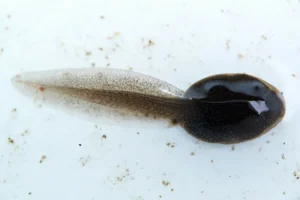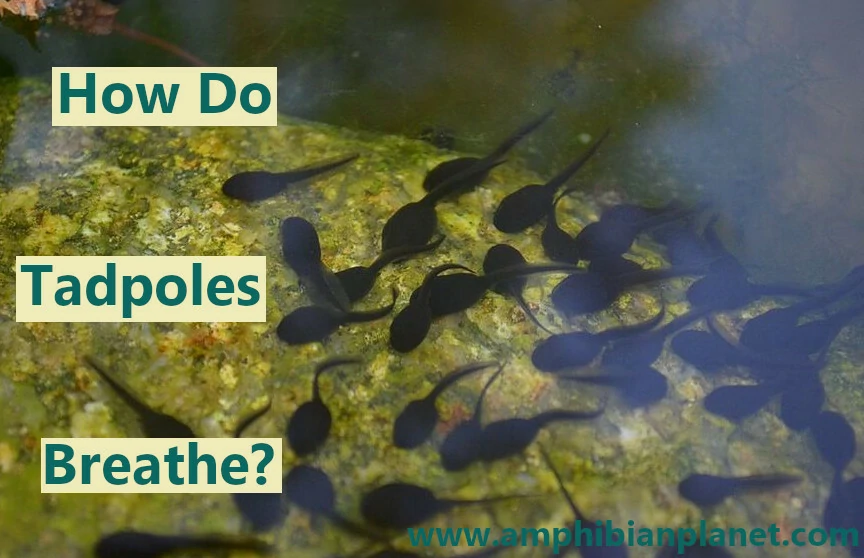Most frogs (not all) start their lives as tiny tadpoles. Tadpoles are very different from adult frogs; this is because they’re adapted for a fully aquatic life, while adult frogs are adapted for a semi-aquatic, or mostly terrestrial life (depending on the species).
Tadpoles breathe through external gills when they first hatch. Over time, the external gills develop into internal gills. In addition to gills, tadpoles also breathe through the thin and highly vascularized skin of their large tail fins, and some tadpoles also breathe using their lungs.
When the tadpoles reach the froglet stage of development, they lose their gills.
Once the gills are lost, the froglets will breathe using their lungs as well as through their skin and thin membranes in their mouth and throat.
When metamorphosis fully is complete, the froglets will be young frogs and will leave the water to live on land. These young frogs will grow and mature into adults over time.
Early-Stage Tadpoles Breathe Using External Gills
When first hatched, tadpoles have visible external gills, often in pairs, on either side of their heads. They use these gills to breathe in the water, just like fish.
The gills have thin membranes and a very large network of small blood vessels called capillaries. As water runs over the gills, the membranes absorb dissolved oxygen from the water and move it into the bloodstream.


The tadpole’s heart then pumps the oxygenated blood to distribute the oxygen throughout the body, just like in humans.
At the same time, waste carbon dioxide in the blood passes through the gills, and into the water.
Tadpoles Midway in Their Development Breathe Using Internal Gills
When tadpoles are about 4 – 6 weeks old, opercular folds grow backward from the hyoid arch of each side covering the external gills and gill slits.
In this way, a gill cover known as an “operculum” is formed enclosing the external gills and gill slits – turning the external gills into internal gills. These internal gills are vented by ventrolateral openings, known as spiracles.

Depending on the species, there can be:
- Two spiracles on both sides of the body,
- A single spiracle on the underside near the vent, or
- A single spiracle on the left side of the body
Spiracles are tubular structures leading out of the opercular chamber. Tadpoles eject water through the nostrils and through the spiracles.
Tadpoles Also Breathe Through Their Skin
In addition to gills, tadpoles also breathe by taking in oxygen through their skin, especially the skin of their large tail fins.

The skin is made up of thin membranous tissue that is highly permeable to water and contains a large network of capillaries and other blood vessels close to the surface.
The thin membranous skin allows oxygen from the air to be absorbed into the bloodstream via diffusion. At the same time, carbon dioxide from the bloodstream passes through the skin and membranes and is diffused into the water.
This process of “skin breathing” is known as cutaneous respiration.
Many Tadpoles Breathe Using Their Lungs in Addition to Gills & Skin
It was previously believed that tadpoles lacked lungs throughout most of the larval period, relying on gills and cutaneous respiration for gas exchange until lungs and air breathing developed during metamorphosis in preparation for adult life.
However, with new scientific research, it is now widely known that the development of lungs in many tadpoles occurs well before metamorphosis.
A study of the tadpoles of five frog species representing three families found that they all began to inflate their lungs and breathe air within 3 or 4 days of hatching.
In addition, another study confirmed that Gray tree frog (Hyla versicolor) tadpoles develop lungs and begin breathing air within 3 days of hatching.
Air-breathing is essential for survival in water with low oxygen levels – where their gills (and skin) cannot absorb sufficient oxygen.
Many tadpoles experience hypoxic waters for some if not most of their lives. This problem is worsened by the fact that most frogs avoid laying eggs in open, more oxygenated waters due to the presence of predators such as fish and turtles.
A study found that African clawed frog (Xenopus laevis) tadpoles obtain 16.6% of their oxygen from air in normoxic water. However, this increases to 100% of net oxygen consumption in hypoxic water.
In addition, another study found that American bullfrog (Lithobates catesbeianus) tadpoles obtain 15% of their oxygen from air at the start of lung use, and 80% at the end of climax metamorphosis.
How Tadpoles Breathe Air
When they first hatch, tadpoles are too feeble to break through the water’s surface for a gulp of air. To get around this, they “bubble-suck”.

To do this, they first attach their open mouths to the underside of the water’s surface. They then open their jaws wide and suck at the water’s surface. Doing this creates an air pocket that they can pinch off by quickly closing their jaws.
After they close their mouth, a portion of the fresh air bubble is forced down into their lungs;
Since the tadpoles are tiny, they usually cannot absorb the entire air bubble, and the excess is burped out as a small bubble, after which it floats back up to the water’s surface.
Once the tadpoles get bigger, they will be strong enough to break through the water’s surface for a gulp of air (‘breach breathing’).
However, the tadpoles of some frog species such as the Gray tree frog (Hyla versicolor) continue to bubble-suck throughout the larval period and well into metamorphosis, despite growing large and fast enough to breach the surface.
Air-Breathing/Lung Filling at Very Early Stages May Be Non-respiratory
Histological analysis of Gray tree frog (Hyla versicolor) tadpoles showed that their lungs do not become highly vascularized until sometime later in development – when the tadpoles grow to be approximately 6 mm snout to vent length (SVL).
Although the tadpoles of other frog species have been poorly studied in this regard, it may be true for other species, as well.
For this reason, researchers have theorized that air-breathing/lung filling in many tadpoles at very early stages may be non-respiratory.
If air-breathing at early stages is non-respiratory, inflated lungs may have functions other than respiration.
1. Buoyancy
A Study by John H. Gee and Ruth C. Waldick showed that Gray tree frog (Hyla versicolor) tadpoles use inflated lungs to promote neutral buoyancy, which may help reduce the energetic cost of holding position in the water.
2. Normal Lung Development
Air-breathing may also be necessary for normal lung development in some species.
An experiment on African clawed frog (Xenopus laevis) tadpoles found that those that were denied access to air after hatching had lungs one-half the size of those that had access to air.
It was also found that the longer tadpoles were denied access to air, the longer they took to metamorphose, and their probability of successful metamorphosis significantly decreased.
One tadpole raised throughout its larval life without access to air successfully metamorphosed but had abnormal, solidified lungs and an enlarged heart.
This experiment demonstrated that lung use during early larval development in African clawed frogs is not necessary for survival through metamorphosis, but its absence severely handicaps growth.
Tadpoles Delay Lung Inflation to Different Stages
Although the tadpoles of many frog species start using lungs soon after hatching, it’s important to note that delay tadpoles’ lung inflation (meaning the initial act of inflating their lung rudiments with air) to different stages after hatching – depending on the species.
Not all tadpoles breathe using their lungs shortly after hatching.
For example, the tadpoles American bullfrogs (Lithobates catesbeianus) do not inflate their lungs until mid-tadpole stages. Before the start of lung use, the tadpoles strictly breathe using their gills, and skin.
Other tadpoles such as those of the coastal tailed frog (Ascaphus truei), Lace-eyed Tree Frog (Litoria dayi), Goose frogs (Megophryidae), European spadefoot toads (Pelobatidae), North American spadefoot toads (Scaphiopus), and bufonid toads – delay lung inflation until metamorphosis.
Stage of Development |
Organs for Gas Exchange |
| Early Tadpole | External gills, Skin, (and Lungs in some species) |
| Mid Tadpole | Internal gills, Skin, (and Lungs in some species) |
| Late Tadpole | Internal gills, Skin (and Lungs in some species) |
| Froglet | Lungs, Skin, and membranes in the mouth and throat |
| Adult frog | Lungs, Skin, and membranes in the mouth and throat |
Common Questions About Tadpole Respiration
Do tadpoles breathe air?
Tadpoles begin to breathe air at different stages of development, depending on the species. Some tadpoles such as those of the African clawed frog use their lungs to breathe only a few days after hatching, while others such as those of the American bullfrog begin to breathe air in mid-tadpole stages. Other tadpoles, such as those of bufonid toads do not breathe air until metamorphosis.
When do tadpoles breathe air?
In general, tadpoles breathe air breath air when they develop functional lungs. The onset of air breathing/lung inflation varies among different species. Some tadpoles such as those of the African clawed frog begin to breathe air only a few days after hatching, while those of bufonid toads breathe air only when they reach metamorphosis.
Do tadpoles need air?
In general, tadpoles do not need air until they develop functional lungs. Before the start of lung use, tadpoles can get all the oxygen they need through aquatic respiration alone. That said, many tadpoles with lungs can survive without air for many days in normoxic water, relying only on aquatic respiration.
Do tadpoles breathe through their skin?
In addition to their gills, and lungs, tadpoles also breathe through their skin, especially the thin and highly vascularized skin of their large tail fins. Dissolved oxygen from the water is absorbed through the skin, into the bloodstream and carbon dioxide is diffused out.
Do tadpoles breathe through lungs?
Tadpoles begin to breathe through their lungs at different stages of development, depending on the species.
Some tadpoles such as those of the Gray tree frog, and African clawed frog, breathe through their lungs only a few days after hatching, while others such as those of the American bullfrog begin to breathe through their lungs in mid-tadpole stages.
Other tadpoles, such as those of bufonid toads do not breathe through their lungs until metamorphosis.
Do tadpoles breathe through gills?
Tadpoles breathe through gills, in addition to their skin, and their lungs (depending on the species and/or stage of development).
Sources:
Schwenk, K., Phillips, J. (2020). Circumventing Surface Tension: Tadpoles Suck Bubbles To Breathe Air. Proc. R. Soc. B., 1921(287), 20192704. https://doi.org/10.1098/rspb.2019.2704
Scott Pronych and Richard Wassersug. 2011. Lung use and development in Xenopus laevis tadpoles. Canadian Journal of Zoology. 72(4): 738-743. https://doi.org/10.1139/z94-099
Jackson R. Phillips, Amanda E. Hewes, Kurt Schwenk; The mechanics of air breathing in gray tree frog tadpoles, Hyla versicolor (Anura: Hylidae). J Exp Biol 1 March 2020; 223 (5): jeb219311. doi: https://doi.org/10.1242/jeb.219311
Gee, J. H., & Waldick, R. C. (1995). Ontogenetic Buoyancy Changes and Hydrostatic Control in Larval Anurans. Copeia, 1995(4), 861–870. https://doi.org/10.2307/1447034
Christopher S. Rose, Brandon James; Plasticity of lung development in the amphibian, Xenopus laevis. Biol Open 15 December 2013; 2 (12): 1324–1335. doi: https://doi.org/10.1242/bio.20133772
Richard J. Wassersug, Masamichi Yamashita. The mechanics of air-breathing in anuran larvae: Implications to the development of amphibians in microgravity, Advances in Space Research, Volume 25, Issue 10,2000, Pages 2007-2013, ISSN 0273-1177, https://doi.org/10.1016/S0273-1177(99)01006-6.
Warren W. Burggren, Nigel H. West, Changing respiratory importance of gills, lungs and skin during metamorphosis in the bullfrog rana catesbeiana, Respiration Physiology, Volume 47, Issue 2, 1982, Pages 151-164, ISSN 0034-5687, https://doi.org/10.1016/0034-5687(82)90108-6.
Martin E. Feder, Richard J. Wassersug; Aerial Versus Aquatic Oxygen Consumption in Larvae of the Clawed Frog, Xenopus Laevis. J Exp Biol 1 January 1984; 108 (1): 231–245. doi: https://doi.org/10.1242/jeb.108.1.231
Jackson R Phillips, Jens Reissig & Gary Kyle Nicolau (2023) Notes on lung development in South African ghost frogs (Anura: Heleophrynidae), African Journal of Herpetology, 72:1, 81-90 , DOI: 10.1080/21564574.2023.2191602

